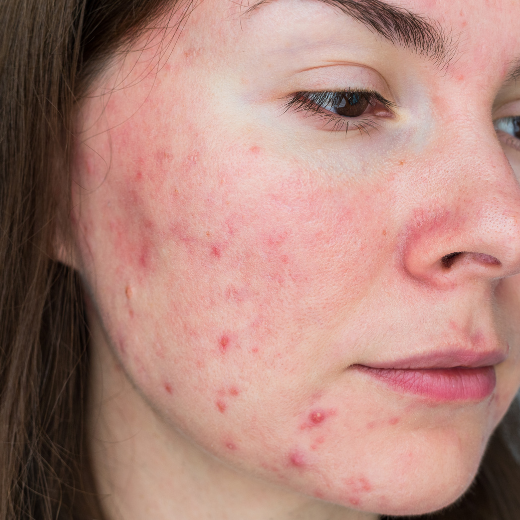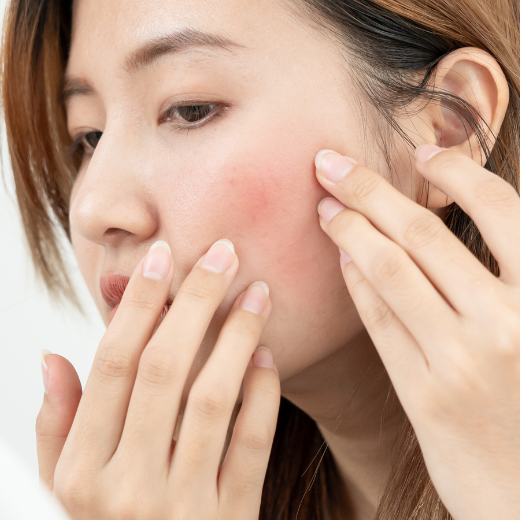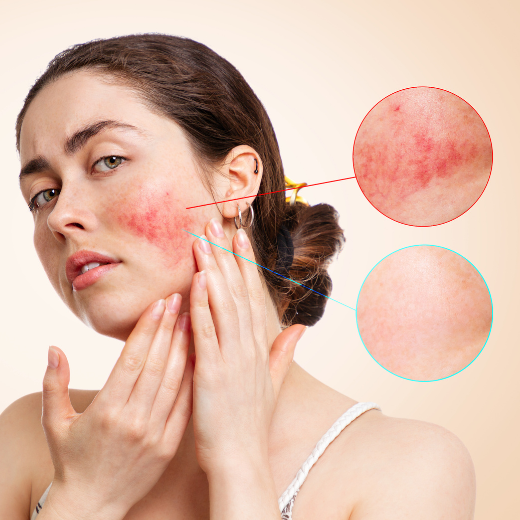Adult Acne or Rosacea: How Can You Tell?
Posted by Nikki Wisher on Apr 16th 2024
April is more than just the month when we get all the showers that give us May flowers…it’s Rosacea Awareness Month, too! In honor of this month, let’s talk about a question that probably everyone with rosacea asked themselves when they started noticing their symptoms: is it adult acne or rosacea?
These tricky conditions can look suspiciously similar – both of them can cause pimples or bumps on your face, and both have symptoms that come and go or rise and fall. While the only way to know for sure is to see your dermatologist, there are some questions you can ask that will give you a pretty reliable guestimate of whether your breakouts are caused by rosacea or adult acne.
How Does Your Skin Look Beyond Your Pimples?
The bumps and blemishes on your skin might be what’s standing out to you the most when you look in the mirror, but take a closer look at the skin between those pimples. With rosacea, your face will look flushed and red in addition to the blemishes. With acne, the inflammation is generally limited to the pimples themselves.
When Did Your Symptoms Start?
Everyone is unique, but rosacea symptoms most often develop at age 30 or later, so if you didn’t start seeing symptoms until that age, it might be rosacea. Acne is less consistent, though. Some people with adult acne started having acne as teens and it never went away. Others saw their acne go away in their 20s but reappear later, or didn’t even have acne until after their teen years.
Where Do You Have Symptoms?
While skin with acne and skin with rosacea often look alike, the location of your symptoms can be a clue. Rosacea is limited to your face, and almost always to specific parts of the face: particularly your cheeks, nose, and forehead, and sometimes your eyes or eyelids. Acne, on the other hand, can appear anywhere – throughout your face as well as your back, chest, and elsewhere.
How Do Your Pimples Look?
We’re getting into the nitty-gritty here a bit, but as you might have noticed, not all pimples look the same. The type of blemishes you get can be a clue as to whether you have rosacea or acne. Acne can produce many types of blemishes: simple red bumps as well as whiteheads, blackheads, and deep cysts. Rosacea, on the other hand, doesn’t usually cause whiteheads or blackheads, just red pimples.

Do You Have Trigger-Related Flushing?
One reliable sign that you might have rosacea instead of acne is frequent flushing from specific triggers. Everyone with rosacea has different triggers, but it’s a hint that you could have rosacea if your face gets red in response to things like hot weather or cold weather, strenuous exercise, sun exposure, spicy foods, or alcohol. That flushing could last for a matter of minutes or hours, or sometimes longer. Acne doesn’t typically cause flushing.
Do You Have Eye Symptoms?
While it’s less common, rosacea sometimes causes eye symptoms too. Your eyes could be sensitive and become red or bloodshot easily, or you might frequently have swollen eyelids or other discomfort in your eyes. Acne doesn’t affect eyes, so these symptoms could point to rosacea.
What is Your Family’s Skin History?
Both rosacea and acne can run in families, but especially rosacea. Consider your immediate or close family and if you have one or more people with either adult acne or rosacea, that’s a helpful hint about what you might have.
Kind in mind, though, that many people with rosacea aren’t diagnosed – a person with rosacea who doesn’t see a dermatologist regularly often just thinks they have naturally sensitive skin or that they blush easily. So think about your family members’ skin symptoms – if one or more people have frequent skin redness, it could mean that rosacea runs in your family.
What to Do if You Suspect You May Have Rosacea
The checklist above can give you a good idea of whether you have rosacea or acne. If you suspect that you have rosacea, what next? Start with these simple steps.
Book a Dermatology Appointment
Ultimately, only a dermatologist can confirm whether you have rosacea and give you the specialized treatment. Keep in mind that rosacea is a chronic condition so it won’t go away, but with targeted and personalized treatment like topical or oral medications, you can manage it so that symptoms are few and far between.
Start Tracking and Avoiding Triggers
As I mentioned, skin with rosacea gets red when it encounters triggers like certain foods or environments. Everyone’s triggers are different, so start keeping a log of when your symptoms are better or worse and what might have triggered the flare-ups. Do you see more redness when you go to hot yoga, for example, or when you drink red wine or spend time in the sun? Start taking note and try to avoid your top triggers – or at least allow yourself to plan accordingly so you’re not scheduling a dinner date after hot yoga, for instance, or so you can wear sunscreen to reduce sun exposure.
Sensitize Your Skin Care
If you have rosacea, your skin will generally be more sensitive than average, so this should inform your skin care choices. Take a break from harsh skin care products like exfoliants and peels (you might be able to bring them back in if you can get your symptoms under control) and use products specifically designed for sensitive skin like a sensitive skin moisturizer.
Embarking on Your Skin Discovery Journey
Whether or not you have rosacea, understanding more about your skin and its specific needs is helpful for everyone. It allows you to make better choices about how to care for your skin on a daily basis. As someone who herself has rosacea, I can tell you that the more you know, the more beautiful your skin can be! And rest assured that no matter what your skin needs, chances are that you can find it among Skin Elite’s premium skin care selection.


